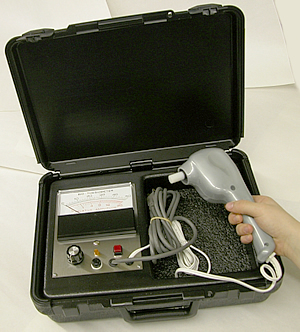Biothesiometry
Biothesiometry is a medical diagnostic technique used to measure an individual's sensitivity to vibration. This method is particularly useful in assessing sensory nerve function and has been widely applied in the diagnosis and management of peripheral neuropathies, such as those associated with diabetes mellitus, where it can detect early signs of nerve damage. Biothesiometry provides a quantitative assessment of vibration perception threshold (VPT), which is a critical parameter in evaluating the integrity of sensory nerves.
Overview[edit | edit source]
The principle behind biothesiometry involves the application of a variable amplitude vibration to the skin and recording the minimum amplitude at which the vibration is perceived by the patient. This threshold is indicative of the sensory nerve's ability to transmit vibration signals to the brain. A biothesiometer, the device used in this technique, typically consists of a vibrating probe that can be adjusted in terms of frequency and amplitude. The most common sites for testing include the fingertips and toes, as these areas are often the first to exhibit signs of neuropathy in conditions like diabetes mellitus.
Clinical Applications[edit | edit source]
Biothesiometry is primarily used in the clinical setting to:
- Detect early signs of peripheral neuropathy, especially in patients with diabetes mellitus.
- Monitor the progression of neuropathic conditions.
- Evaluate the efficacy of treatment interventions aimed at improving nerve function.
- Assess risk factors for the development of diabetic foot ulcers, which are a significant complication of diabetic neuropathy.
Procedure[edit | edit source]
The biothesiometry test is non-invasive and straightforward. The patient is seated comfortably, and the skin area to be tested is exposed. The biothesiometer's probe is then placed on the site, and the vibration amplitude is gradually increased until the patient indicates perception. This process is repeated on various sites, typically starting from areas known to have higher thresholds (e.g., the toes) and moving to those with lower thresholds (e.g., the fingers). The vibration perception threshold is recorded, and values above the normal range indicate sensory nerve impairment.
Advantages and Limitations[edit | edit source]
Biothesiometry offers several advantages, including its non-invasive nature, ease of use, and the ability to provide quantitative data on nerve function. However, it also has limitations. The interpretation of results can be subjective, as it relies on patient response. Additionally, biothesiometry is sensitive to changes in skin temperature and circulation, which can affect the vibration perception threshold. Therefore, results must be interpreted in the context of the overall clinical picture.
Conclusion[edit | edit source]
Biothesiometry is a valuable tool in the assessment of sensory nerve function, particularly in the early detection and management of peripheral neuropathies. Despite its limitations, when used alongside other diagnostic methods, it can provide crucial information on the extent of nerve damage and guide treatment decisions.
Translate: - East Asian
中文,
日本,
한국어,
South Asian
हिन्दी,
தமிழ்,
తెలుగు,
Urdu,
ಕನ್ನಡ,
Southeast Asian
Indonesian,
Vietnamese,
Thai,
မြန်မာဘာသာ,
বাংলা
European
español,
Deutsch,
français,
Greek,
português do Brasil,
polski,
română,
русский,
Nederlands,
norsk,
svenska,
suomi,
Italian
Middle Eastern & African
عربى,
Turkish,
Persian,
Hebrew,
Afrikaans,
isiZulu,
Kiswahili,
Other
Bulgarian,
Hungarian,
Czech,
Swedish,
മലയാളം,
मराठी,
ਪੰਜਾਬੀ,
ગુજરાતી,
Portuguese,
Ukrainian
Navigation: Wellness - Encyclopedia - Health topics - Disease Index - Drugs - World Directory - Gray's Anatomy - Keto diet - Recipes
Search WikiMD
Ad.Tired of being Overweight? Try W8MD's physician weight loss program.
Semaglutide (Ozempic / Wegovy and Tirzepatide (Mounjaro) available.
Advertise on WikiMD
WikiMD is not a substitute for professional medical advice. See full disclaimer.
Credits:Most images are courtesy of Wikimedia commons, and templates Wikipedia, licensed under CC BY SA or similar.
Contributors: Prab R. Tumpati, MD


